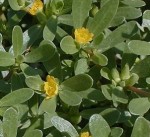 The origin of purslane is somewhat obscure. It appears to be indigenous to North Africa, the Middle East, and parts of Asia but archaeological evidence suggests that it may have been in North America 5,000 years ago. It presently is widespread in the United States, growing in every state including Hawaii and Alaska. Purslane prefers medium to dry soil in full sun, and tolerates heat and drought well. It likes disturbed soil and shows up in gardens, lawns, orchards, croplands, barnyards and waste areas, as well as cracks in walls and pavement. Its ability to grow in hard, compacted soil makes it a good companion plants for plants such as corn that have roots less able to penetrate the soil and the roots of such plants follow the path of the purslane as they grow downward.
The origin of purslane is somewhat obscure. It appears to be indigenous to North Africa, the Middle East, and parts of Asia but archaeological evidence suggests that it may have been in North America 5,000 years ago. It presently is widespread in the United States, growing in every state including Hawaii and Alaska. Purslane prefers medium to dry soil in full sun, and tolerates heat and drought well. It likes disturbed soil and shows up in gardens, lawns, orchards, croplands, barnyards and waste areas, as well as cracks in walls and pavement. Its ability to grow in hard, compacted soil makes it a good companion plants for plants such as corn that have roots less able to penetrate the soil and the roots of such plants follow the path of the purslane as they grow downward.
 Description: Purslane is prostrate, fleshy, succulent summer annual related to moss rose commonly grown as a garden plant. The green or purplish-red stems are smooth and highly branched, growing to a mat 4 inches high and up to 2 feet across. Stems that are broken grow roots and reproduce a new plant. The alternate or nearly opposite leaves are sessile, shiny, light green to reddish green, fleshy and up to 2 inches long. The yellow flowers have five petals are produced singly or in small terminal clusters and are about 1.5 inches across. Plants bloom from mid summer to fall but the flowers open only when the sun is shining. Each flower produces a seed capsule with numerous small brown to black seeds that can remain in the soil for up to 40 years. A single plant can produce up to 240,000 seeds. The root system is a taproot with fibrous secondary roots.
Description: Purslane is prostrate, fleshy, succulent summer annual related to moss rose commonly grown as a garden plant. The green or purplish-red stems are smooth and highly branched, growing to a mat 4 inches high and up to 2 feet across. Stems that are broken grow roots and reproduce a new plant. The alternate or nearly opposite leaves are sessile, shiny, light green to reddish green, fleshy and up to 2 inches long. The yellow flowers have five petals are produced singly or in small terminal clusters and are about 1.5 inches across. Plants bloom from mid summer to fall but the flowers open only when the sun is shining. Each flower produces a seed capsule with numerous small brown to black seeds that can remain in the soil for up to 40 years. A single plant can produce up to 240,000 seeds. The root system is a taproot with fibrous secondary roots.

 Control: Control of purslance can be challenging because of the ability of the prodigious seed production, long viability of the seeds, and the ability of the stems to vegetatively reproduce the plant. Digging out young plants when the soil is wet is not difficult but care must be taken not to leave stem parts behind. A 3 inch layer of mulch effectively inhibits the appearance of new plants. Solarization (cover the plants with clear plastic for 4-6 weeks) is also effective. In unusual circumstances when chemical control seems necessary, a pre-emergent herbicide containing oryzalin or pendimethalin or post-emergent herbicides containing dicambra or 2,4-D can be used. Post-emergent herbicides are most effective when the plants are young and when used on mature plants may produce incomplete control. Individual plants can be eliminated with glyphosate.
Control: Control of purslance can be challenging because of the ability of the prodigious seed production, long viability of the seeds, and the ability of the stems to vegetatively reproduce the plant. Digging out young plants when the soil is wet is not difficult but care must be taken not to leave stem parts behind. A 3 inch layer of mulch effectively inhibits the appearance of new plants. Solarization (cover the plants with clear plastic for 4-6 weeks) is also effective. In unusual circumstances when chemical control seems necessary, a pre-emergent herbicide containing oryzalin or pendimethalin or post-emergent herbicides containing dicambra or 2,4-D can be used. Post-emergent herbicides are most effective when the plants are young and when used on mature plants may produce incomplete control. Individual plants can be eliminated with glyphosate.